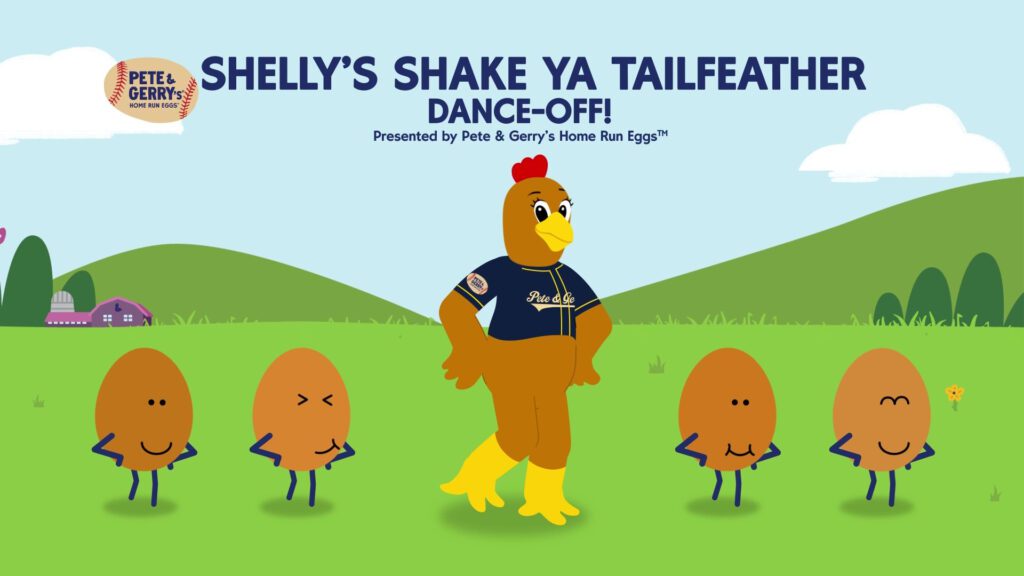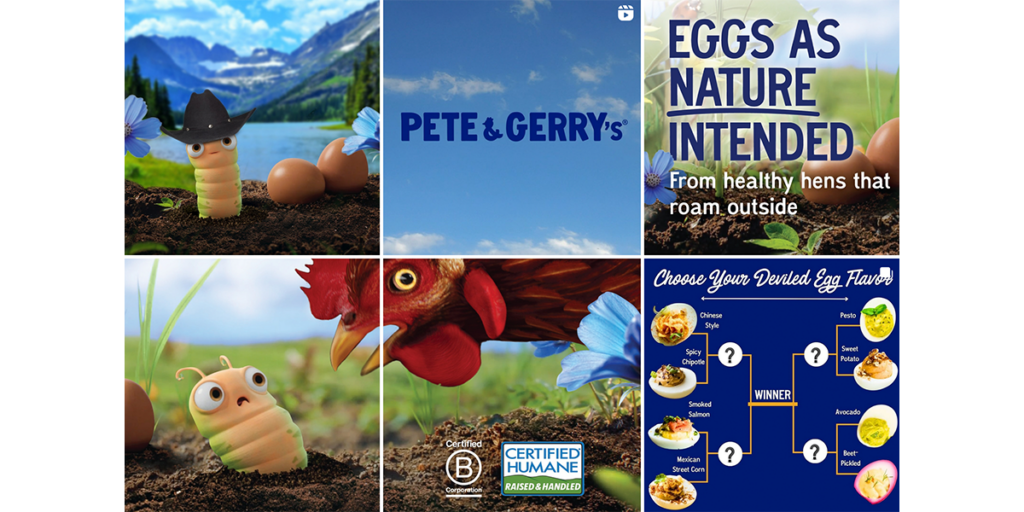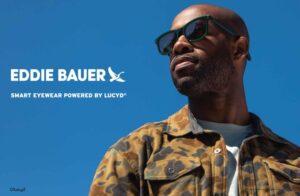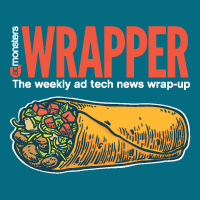“We want to make sure that we’re educating consumers, but not in a preachy way, and not in a way that is overly emphasizing the science behind it all. We don’t want our consumers to feel like they need to get a PhD in eggs to go shopping.”
—Phyllis Rothschild, CMO at Pete & Gerry’s
Communicating to consumers in the premium egg category requires an element of education—but not the pedantic kind. Because while the target customer is discerning, the end goal is to inspire a swift, informed shopping decision without getting bogged down by the details, according to Phyllis Rothschild, CMO at Pete & Gerry’s.
Alongside marketing messages that aim to mitigate confusion, the brand infuses levity, colorful creative and an ethos of transparency into its omnichannel approach. We spoke with Rothschild about the company’s marketing strategy, recent campaigns, creative, category challenges and more.
Chief Marketer: What inspired your most recent campaign? What insights were you working off of?
Phyllis Rothschild, CMO at Pete & Gerry’s, LLC: We launched “Pete & Gerry’s: Eggs As Nature Intended,” with our newly hired “spokesworm.” We realized that a lot of people are confused when they’re purchasing eggs, and particularly with all the claims and phrases that are associated with the egg aisle, whether that’s free range, pasture-raised, organic, cage-free… and there’s not a lot of distinction in people’s minds between all of those phrases. So we really do want to make sure that we’re educating consumers, but not in a preachy way, and not in a way that is overly emphasizing the science behind it all. We don’t want our consumers to feel like they need to get a PhD in eggs to go shopping.
And so what we did is we really tried to hone in on a singular message around organic. And that’s what that particular campaign is meant to support. The true meaning is that hens go outside and they eat bugs and worms and grass. That was the original intention behind the messaging. But we also wanted to build off of our previous campaign, which was “Almost the Wildest Eggs You Can Get” which has a very fun, offbeat humor to it, a little bit more whimsical. It allows people to, one, remember the name. We’re trying to build brand awareness for Pete & Gerry’s. It allows people to have fun and engage, and that makes it more memorable. But there’s a singular message behind it: organic eggs are laid by hens who go outside and eat bugs and worms.
CM: What kind of customers are you trying to acquire?
PR: In particular, because we’re in the premium egg category, it’s more discerning consumers who are concerned about care for their families. It’s primarily women who are making these shopping decisions in the organic space. It’s someone who’s very focused on health and wellness, and they associate what they’re putting in their body as a form of driving toward health and wellness. So that tends to be a shortcut for organic buyers.
And then more broadly, it’s also consumers who are concerned about animal welfare. The association with free range or pasture-raised suggests to them that the hens are well cared for and they’re outside living like chickens are supposed to be living. It’s more of that emphasis on trying to get the best for their families and put the best products in their bodies.
CM: Looking at your creative on your site and on social, it’s clear that you put a lot of effort into the design, the animation, and how it’s presented. What is your focus when it comes to communicating those things to prospective buyers and customers?
PR: First, thank you for that. There are a few things that we want to emphasize across our omnichannel approach. One is transparency. We definitely want consumers to feel like they can trust in what we’re saying and how we’re communicating. So we’re very clear about what we’re trying to convey to consumers. We talk about our hen care, we talk about our family farms that we partner with, and we’re very open about the way we approach delivering as one of the top premium egg producers.
The second is convenience. We want people to be able to look quickly and make that association. So you see some of the bright colors, the powerful visual elements that are associated. We want people to be able to quickly identify us, whether they’re shopping physically in the store or online, that pop of yellow or that pop of navy blue, or a cute hen or a cute girl on a package, with our Nellie’s Free Range brand. Those things can be highly associated with our brands and not require the consumer to do too much work.
And then third, which I touched on before, is education, because there’s so much confusion in the space. We want to be smart about how we’re educating consumers so that they’re making the best choices for themselves and their families. But we don’t want to do it in an overly, schoolmarmy teacher kind of way and want do it in a fun, accessible, memorable way that feels inclusive to the consumer—so that they know that no matter what premium choices they’re making, whether it’s free range, pasture-raised, organic, they can rely on us and be included in our overall set of brands and offerings.
View this post on Instagram
CM: What are the biggest marketing challenges that you face within your category?
PR: Clearly it’s the confusion. That’s one. Being able to overcome that and get people to understand what they’re buying is actually what they think they’re buying. I think the most confusing term out there is probably “cage free.” A lot of consumers associate that with hens running around freely, but they’re actually not really free. They’re confined to buildings and barely ever go outside. So that’s one of the biggest challenges.
Two, is the perception around pricing that we’re experiencing these days. Clearly consumers are being affected by inflation and what’s happening in the stores with prices across multiple categories, but eggs do get a lot of attention because it’s a weekly staple, and because the egg category has been affected by avian influenza for these past couple of years, which has driven the eggs at the commodity, low-end of the category pricing to go up. That is the bulk of what consumers in the United States are purchasing and they’re experiencing that price increase.
What’s interesting is that in the premium space where we play, we haven’t really seen a price increase year over year. And so it’s that understanding of knowing that you could just step up a little bit. The gap has actually closed in the price points between commodity and premium. So you could trade up a little bit and get so much more value for your family, whether that’s the hen welfare side of it, the quality of the egg itself, or the organic feed side of it.
The other thing related to the pricing is that when you compare the sources of protein that you can get out in the market, eggs are actually one of the cheapest forms of protein gram. Relative to beef or fish or chicken on a protein grams per serving [basis], you can get them at a much more inexpensive rate than you can for some of those other options.
CM: So in a sense the price increases for the non-premium products could be an advantage for you.
PR: Sure, because it’s causing the consumer to pause, and say, hey, what’s happening with the egg prices? If I just spend, in some cases, only a dollar more for a dozen, I can actually get a better product, feel good about what I’m purchasing, know that they’re treating the animals well and be much more satisfied with that purchase. In some cases, there’s legislation happening right now across multiple states around cage free. I live in Massachusetts. We’re a state that actually has gone cage free and above since 2022.
But we’re seeing it happen across different states. There will be five in 2025 that are going to legislate that there can no longer be caged eggs sold in those states. And in those cases, [consumers are] automatically being forced to make that decision, because there’s no longer that very inexpensive offer at the low end. They’re automatically going to have to step up to cage free. And for us, while that’s a challenge, it’s also a great opportunity because it gives us a chance to capture that consumer in that moment of choice and say, why, first of all, do I have to buy this one? What does cage free mean? Maybe I should step up a little bit and and buy a free range option instead.
CM: How do you set yourself apart from competitors that are already in the cage free category?
PR: From the cage free distinction, we can offer our portfolio of products, whether it’s Nellie’s Free Range, which is the number one free range egg sold today, or Pete & Gerry’s organic free range, which is the number one organic free range egg sold today in the U.S., or the Pete & Gerry’s pasture-raised option, which just provides that much more space per hen on open pastures. So, first is our product portfolio, and being able to offer that to consumers who are making smart choices for their families.
The second is once you start to get into that premium space, it’s really what we’re doing with the brand, trying to make it very inclusive, accessible, understandable and fun. You mentioned some of the stuff we’re doing on social media. We’re really pushing hard toward engaging, offering consumers and our social fans interesting ways to use eggs—recipes galore. And not just for breakfast, but across the board, celebrating family holidays together, and interesting ways to use eggs even outside of recipes. It’s that content that we’re creating and that personality that we’re associating with it that truly creates a differentiation for us.
CM: How did you grow your following on social organically this way?
PR: We’ve been growing our following pretty significantly over the past two years. A lot of it has been increased that way, but we’ve also done offers, different giveaways, that I think gets people excited and certainly to sign up, whether it’s a year of free eggs or a partnership with a like-minded brand, for instance. We’ve also done sweepstakes, and then we launched a white-labeled loyalty program that allows people to join “our flock” and get offers in exchange. We launched it with a $2 back offer, but that also gets people more engaged. And then this year we did sponsor Minor League Baseball. We became the official egg of minor league baseball, and that gave us many, many eyeballs that got exposed to our Pete & Gerry’s brand, and allowed them to sign up for different offers and to learn more about who we are and what we do.
We actually partnered with Major League Baseball last year, with the Pete & Gerry’s brand. Historically, we’ve also done little partnerships with the Red Sox, for instance, through our Nellie’s Free Range brand. But last year was probably the most significant one with Major League Baseball where we sponsored the All-Star game out in Seattle. This year was much more comprehensive in terms of the number of teams that we partnered with in the minor league. There were 60, and they allowed us to do on-field activations and engage directly with families—who are mostly the ones attending the minor league games—and really connect with our local communities. We developed a Shelly (who’s our mascot) “Shake Ya Tailfeather” dance that people could do on the field and have a chance to win a month’s worth of free eggs. We also did a national sweepstakes for a year’s worth of free eggs through that partnership.

And then we’re exploring opportunities in the future for other ways we can connect with folks who are engaging in sports but see a natural connection with what we do, whether it’s from a health and wellness perspective, whether it’s from a family engagement perspective, whether it’s for fun appetizers to have to tailgate or while you’re watching a game. Those things we’re always on the hunt for.
CM: What’s your focus for 2025?
PR: Certainly to maintain the momentum that we’ve built around the brands. We’ll extend “Eggs As Nature Intended” and the campaign that we launched with our spokesworm in December, and we’ll extend that into next year. Nellie’s Free Range launched a campaign earlier in the in the fall called “Life’s Better Out Here.” We will continue to extend that into 2025, particularly as we see those cage-free legislation states taking place. We want to target those particular states and regions. Nellie’s is relaunching its Egg Bites. We’re the only free range egg bite, so that’s going to be in stores in 2025. The first one is a bacon gruyere flavor.
We are partnering with No Kid Hungry, identifying families who are at risk and who can be food- or nutrition-insecure, and making sure that we’re helping support with donations of meals, but also perhaps through different activations to get out in the community and provide them with a highly nutritious offer like eggs. Those are a few things we have in store for next year.








